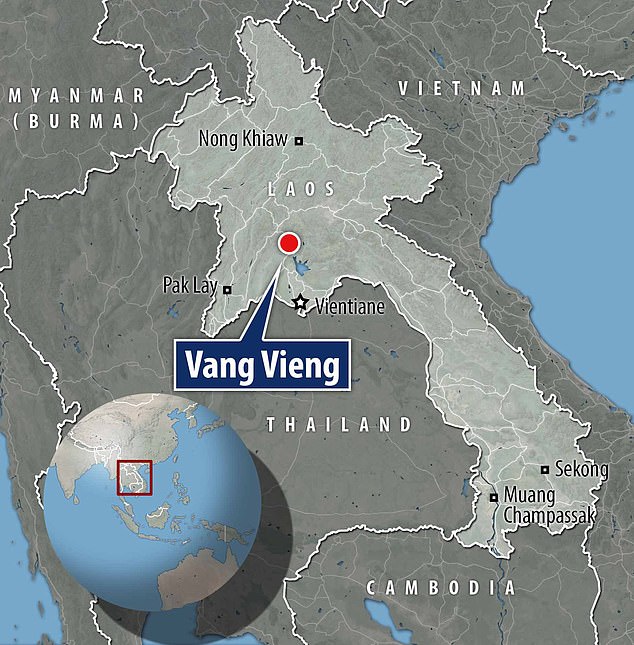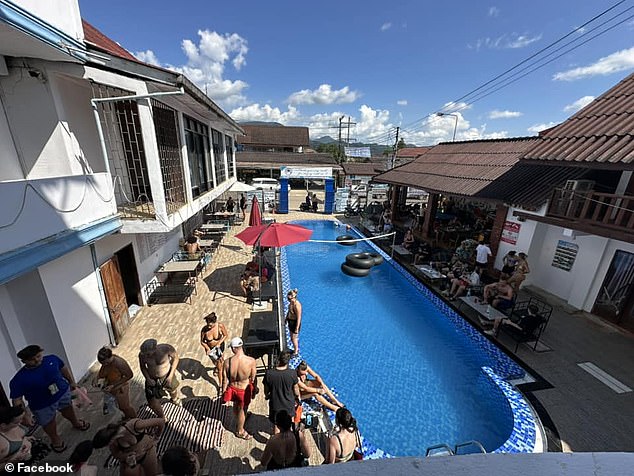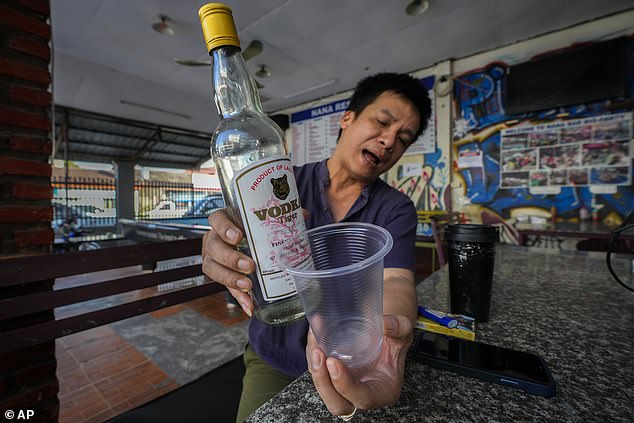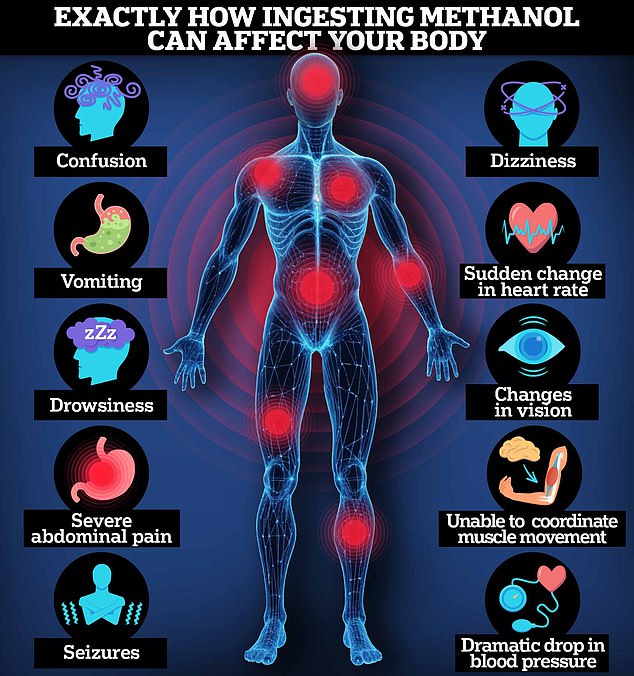It is a common ingredient used in industrial and household products such as paint thinners, antifreeze, varnishes, and even copier fluid.
But now methanol is attracting new attention for its role in the deaths of six foreign tourists who drank drinks allegedly laced with the substance while on holiday in Laos, including that of a young British lawyer.
Here, we reveal how the toxin can wreak havoc on the body within hours of taking it, leaving drinkers paralyzed, unable to breathe and at risk of losing their sight.
Methanol, like the alcohol we consume in beer, wine and spirits, is a colorless liquid that smells similar to alcohol but is much cheaper to produce.
But its effects are much more catastrophic.
According to experts, just half a drink, or 15 ml, of a liquor containing methanol can be enough to kill.
Alarmingly, unscrupulous shops and bars in certain tourist resorts are increasingly using this harmful liquid as a cheap substitute for alcohol, either replacing or mixed with the normal alcohol found in popular drinks.
Symptoms of methanol ingestion can also vary depending on the person and the amount consumed.
Here, we reveal how the substance can wreak havoc on the body within hours of taking it, leaving drinkers paralyzed, unable to breathe and at risk of losing their sight.

Australian Holly Bowles (pictured), 19, died in a hospital in Bangkok, Thailand, after spending 10 days on life support.

Simone White, 28, from Orpington in Kent, died yesterday after drinking free drinks at a Laos hostel allegedly laced with methanol.
Typically, its effects last between just 40 minutes and 72 hours to appear, so prompt treatment of suspected methanol ingestion is vital.
Early signs may reflect alcohol poisoning: drinkers often experience problems with coordination, balance and speech, as well as confusion and vomiting.
At the same time, blood pressure decreases, causing a feeling of dizziness and fainting.
Its numbing effect also makes users unresponsive more quickly.
In this state, drinkers may not be able to coordinate their own muscle movements.
Dr Wayne Carter, Associate Professor at the University of Nottingham, said: “Like alcohol, it oxidizes in the body, but when methanol breaks down it forms a strong and dangerous acid: formic acid.
This causes a person’s blood to become acidic.
And he added: “It also forms a toxic product, formaldehyde, a carcinogenic chemical substance.”


Bianca Jones, 19, has become the fourth person to die after consuming alleged “methanol” drinks in Vang Vieng, Laos.

In a video from September, the best friends danced happily together just weeks before their deadly backpacking trip.
Unlike alcohol poisoning, if enough amounts build up, it can begin to attack the nervous system, especially the optic nerve, which transmits messages between the brain and the eye.
According to the UK Health Safety Agency, vision changes usually occur between 12 and 48 hours after ingesting methanol.
Professor Sir Colin Berry, a pathology expert at Queen Mary University of London, said these can range from mild sensitivity to light and “hazy or blurred vision” to “visual hallucinations” such as dancing dots and flashes, or even “partial or total vision.” loss of vision.”
In later stages, around 18 to 48 hours after ingestion, formic acid, which stops energy production in cells, causes the pH of the blood to drop, damaging the body’s tissues and organs.
This can lead to kidney failure, seizures, and even gastrointestinal bleeding.
“Drowsiness can lead to coma,” Sir Colin added.
A dramatic change in heart rate (rapidly speeding up or drastically slowing down) is often a sign of a “fatal case,” says the Centers for Disease Control and Prevention (CDC).
Its effect on muscle relaxation also inhibits the respiratory system, causing sudden difficulty swallowing and difficulty breathing.

The three young women were staying at Nana’s Backpackers Hostel in Vang Vieng.

Police have reportedly detained hostel director and bartender Duong Duc Toan (pictured).
“Low blood pressure (hypotension) and respiratory arrest occur when death is imminent,” the CDC adds.
Treatment often depends on the severity of the poisoning, but only blood tests can confirm this.
It usually involves removing methanol from the blood through dialysis while “keeping someone slightly drunk” by giving them alcohol at the same time, said Professor Alistair Hay, a toxicology expert at the University of Leeds.
“The principle behind alcohol administration is quite simple: it delays the metabolism of methanol,” he added.
‘Both are broken down by the same liver enzyme alcohol dehydrogenase. But the enzyme prefers alcohol.
«Therefore, it acts as an inhibitor, largely preventing the degradation of methanol.
“It slows it down, allowing the body to expel methanol from the lungs and some through the kidneys, and some through sweat.”
This prevents the methanol from eventually being metabolized as formic acid, he added.

The couple’s Melbourne football club said the news was “tragic and distressing”.
The warnings about the risks posed by the toxin come after six deaths in Laos.
The family of Australian teenager Holly Bowles confirmed today that the 19-year-old had died, more than a week after she fell ill in the resort town of Vang Vieng.
Her friend Bianca Jones, 19, and British lawyer Simone White, 28, also died in the horrific incident along with two Danish women, aged 19 and 20, and a 56-year-old American man.
At least 11 other people are believed to remain in hospital.
White, Jones and Bowles were staying at the Nana Backpackers Hostel, where they were given free shots of liquor now believed to contain methanol.
Now the hostel’s director, Duong Duc Toan, has reportedly been detained by local police, who said “several” people had been detained, but no charges have yet been filed.
Staff previously vehemently denied that injections administered at their bar were responsible for the mass poisoning.
But White’s friend Bethany Clarke, a healthcare worker also from Orpington, took to the Laos Backpacking Facebook group to warn other travellers.
She said: “Urgent: avoid all local spirits.” Our group stayed in Vang Vieng and we drank free drinks offered to us by one of the bars.
‘Just avoid them because they’re not worth it. Six of us who drank at the same place are currently in hospital for methanol poisoning.’
The Foreign Office has issued guidance to Brits traveling to the country, warning them not to consume replica brands of alcohol that may contain hidden amounts of methanol.
It says travelers are warned not to consume replica alcohol brands that may contain hidden amounts of methanol.
The latest notice reads: ‘Both male and female tourists have reported having drugs spiked into their drinks or food and, in some cases, being assaulted. Never leave food or drink unattended.
“Be careful when accepting drinks from strangers in bars, clubs, restaurants and parties.”
The recent spate of deaths and critical injuries comes a year after a coroner warned that the British government was not doing enough to warn travelers about the risk posed by contaminated alcoholic drinks following the death of a British woman in Indonesia. .
According to the latest NHS data, there were 15 A&E admissions for methanol poisoning in the UK in 2023/24.
However, many of these are likely cases where methanol-containing products for industrial purposes, such as windshield washer fluid or automobile antifreeze, were accidentally consumed.


